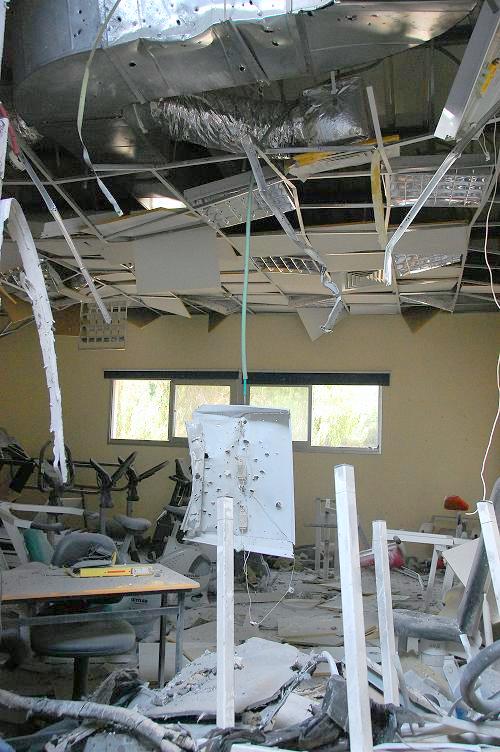On any other day, the facility on the Sapir campus would have been packed with kids, and the losses would have been devastating.
The child hydrotherapy rehabilitation center adjoining Sderot’s Sapir Academic College provides therapy and workshops for specialneeds children who live in the western Negev and is used by children from the entire country.
On Saturday night, an upgraded Qassam rocket scored a direct hit on the ceiling of the center.
Hamas rocket hits children hydrotherapy rehabilitation center. Video: Eliran Hen
The Qassam hit not far from where Sapir student Roni Yechiah was killed on February 27, 2008.
The attack followed the explosion of a Iranian Grad missile that hit the city of Ashkelon on Friday morning.
We are approaching a total of 400 rocket attacks launched from Gaza since the cease-fire that halted Israel’s Operation Cast Lead in Gaza in January 2009.
Palestinians from Hamas controlled Gaza have targeted Ashkelon, with a population of 125,000 Israelis, since March 2008.
A film crew from our Sderot Media Center arrived a few hours after Saturday’s attack, where an IDF Home Front Command officer was assessing the damage.
As the crew filmed, a childcare worker arrived at the destroyed office. She was overwhelmed by the devastation.
She walked through the rubble that had been her office and, looking through the mess, she picked up a photo of her two children that had been hanging on the wall.
Had the rocket struck on any other day, it would have been a catastrophe, killing and wounding the children at the center. During the week the center is open until 10 p.m. and is packed with hundreds of children and therapists.
Home front command officer examining Qassam shrapnel. Photos:Noam Bedein
Because there were no casualties the attack has not remained in the headlines for very long. In the eyes of the media and the public, again, because there were no causalities, it was of little importance. The incident came at the height of summer vacation, when weather reports on the expected high temperatures across the nation take precedence over the lethal missiles raining down on southern Israel.
But had there been children at this rehabilitation center during the Qassam strike, and had lives been lost, the IDF might have had no choice but to reenter Gaza, and we might then have witnessed the firing of thousands of upgraded missiles capable of reaching Tel Aviv.
Israeli intelligence confirms that Hamas has assembled an arsenal of thousands of missiles including many with a range of 40 kilometers.
Yet until there is a human catastrophe that would seemingly justify an appropriate military response, Israel continues to supply the Hamas regime in Gaza with humanitarian aid, as well as the bills and coins it needs to maintain its enterprise.
It is common knowledge that everyday items such as fertilizer are used to manufacture fuel for Qassam rockets.
Cement intended for civilian reconstruction is instead used to build and reinforce bunkers and tunnels.
Worker evaluating her destroyed office and holding her sons picture that was hanging a day before. Photo: Noam Bedein
Metal intended for water pipes and streetlight poles ends up in the rocketmanufacturing facilities managed by Hamas.
Furthermore, Israel provides Gaza with electricity, water and sewerage, and has built the power plants in Ashkelon that provide over 70 percent of Gaza’s electricity, which have been a favorite target of Palestinian terrorists.
Ignoring these facts about Hamas, the world holds Israel totally responsible for the Gazan population of 1.4 million.
Yet, five years ago, Israel withdrew its key military and civilian presence from Gaza, giving land for the hope of peace – something that no other democracy in modern history has done.
The writer is a photojournalist, lecturer and founder/director of Sderot Media Center (http://www.sderotmedia.or g.il/). He has conducted briefings and tours for government officials, diplomats, foreign press, and students from around the world.













where are all the countries condemning hamas for all the rocket attacks where is obama. they are all hippocrites.
Noam thanks for the good work that you are doing.I think there is a need for creating awareness and sensitizing the youths on the nonviolence ways of solving conflicts because these are the same people who have been mostly affected and without understanding the need to forgive than seeking revenge.If we nurture this kind of people in the society then there will be great changes but again change begins with oneself.